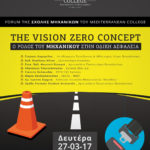
The School of Civil Engineering of Thessaloniki Mediterranean College organised with great success a forum titled: “The Vision Zero Concept: the role of Civil Engineer on Road Safety” on Monday 27 March 2017. This initiative’s goal was to approach road safety, covering three basic branches: the driver, the vehicle and the environment. ![]()

A Diploma Thesis titled ‘Comparative analysis of young drivers behaviour in normal and simulated conditions in urban roads‘ was presented by Danai Voutsina in March 2017. Data have been selected through an experimental process, in which the participants have driven in real urban conditions and on a driving simulator, while performing different scenarios. By using lognormal regression modelling, the impact of the driving environment, the specific characteristics of each driver as well as the driving style to the average vehicle speed change was investigated. The model application revealed that absolute values of drivers’ traffic performance varies between simulated and real driving conditions. However, speed difference between fast and slow drivers is very much the same at the two driving environments, as is also speed difference between drivers talking and not talking to the co-driver at the two driving environments. ![]()
![]()

A Diploma Thesis titled ‘Investigating the acceptance of autonomous vehicles by Greek drivers‘ was presented by Charalampos Souris in March 2017. A stated-preference approach was used that included hypothetical scenarios of cost, time, and safety, which were distributed in a specially developed questionnaire. By using models of logistic regression and the respective utility functions it was possible to extract a mathematical description of the drivers’ attitude towards autonomous vehicles. Results show that the Greek drivers attitude is dependent on the cost, time, and level of safety of the autonomous vehicles, the existence of driving support systems (GPS, parking assistant) in their cars today, their opinion on the traffic of autonomous public transport and taxis on the roads, their driving experience, age, and family income. ![]()
![]()
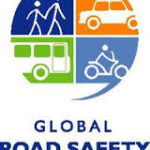
The Global Road Safety Partnership (GRSP) has launched a new series of Positioning Papers, designed to create an understanding of the scale of road traffic deaths and injuries and their linkages to other humanitarian and development issues. The Positioning Papers seek to highlight that road safety is a multidimensional issue that requires an urgent and sustained contribution across many sectors, and that evidence based road safety interventions can address broader development issues such as children’s rights, public health, consumer rights and more. The Positioning Papers further enhance the GRSP’s suite of tools to support road safety advocacy campaign planning, including a general advocacy campaign toolkit and media advocacy toolkit, all of which are available on its Advocacy Tools web page. ![]()

In the context of the Fourth UN Global Road Safety Week, WHO has released a new Report on Managing Speed, which highlights that excessive and inappropriate speed is among the key risks for road traffic deaths and injuries, contributing to around one third of road traffic fatalities in high-income countries and up to one half in low- and middle-income countries. Safe speeds are among the four main elements of the “safe systems approach” to road safety, along with safe roads and roadsides, safe vehicles and safe road users. ![]()
![]()
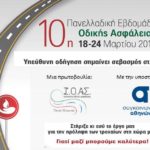
The 10th Road Safety Week organised by the Road Safety Institute ‘Panos Mylonas’ (RSI) and the Hellenic Institute of Transportation Engineers (HITE) on 18-24 March 2017, with information and awareness actions in Attica and throughout Greece, in order to provide appropriate information for accident prevention which are a scourge on our society. With the quote “Responsible driving means respect for life!“, this year’s tenth road safety week gives priority to enhancing road safety, responsible driving and courtesy on the Greek roads, through initiatives for education and awareness to road safety for all users road: students, parents, teachers, citizens and policy makers. ![]()
![]()

The Netherlands’ Institute for Road Safety Research (SWOV) published two reports on Automated Vehicle Safety. The first Report concerns “Safe interaction between cyclists, pedestrians and automated vehicles; What do we know and what do we need to know?” and identifies what is needed to know in order to ensure that an automated driving system, particularly during the transition period, does not compromise the safety of pedestrians and cyclists. ![]()
![]()
The second Report concerns “Safely towards self-driving vehicles; New opportunities, new risks and new challenges during the automation of the traffic system” and describes which developments can be expected during the automation of the traffic system and discusses the implications of these developments for road safety: the opportunities and the risks. ![]()
![]()

This World Health Organisation (WHO) published the new Country Profiles from the “Global status report on road safety 2015” for 52 of 53 Member States in the WHO European Region. It is a companion to the regional data presented in “European facts and the global status report on road safety 2015”; the global status report adds a country-level perspective to allow individual countries to assess their own status with regard to road traffic fatality and policy indicators, to examine the comprehensiveness of legislation on established behavioural risk factors of speeding, drink–driving, and not using motorcycle helmets, seat-belts and child car restraints, to assess road safety audits, policies on mobility and vehicle safety standards and to take stock of progress towards achieving road safety for all road users. ![]()
![]()

The European Transport Safety Council (ETSC) released a Report concerning Drug Driving in Europe, Policy measures for national and EU action, authored by Laurence Atchison. Driving under the influence of psychoactive drugs leads to deaths and serious injuries on Europe’s roads. Both illicit and licit drugs can disrupt the psychological state of the driver and impair their driving performance. Using multiple drugs simultaneously, or in conjunction with alcohol, increases the risk of a collision even further. This report aims to provide a summary of drug driving across Europe, drawing on the latest research to provide an overview of how drugs affect collision risk and the prevalence of different types of drugs in different road users and regions. ![]()
![]()

The Civil Engineering School of the National Technical University of Athens was ranked this year 12th in Europe and 42rd worldwide among all Civil Engineering Schools. This ranking is produced by the QS Organisation (QS World University Rankings by Subject 2017) based on the following criteria: Research, Teaching, Employability, Facilities, Internationalization, Innovation, Engagement and Access. NTUA road safety activities have contributed to this ranking. ![]()
Professor Demetris Koutsoyiannis, Dean of the Civil Engineering School highlighted that the Civil Engineering School improved its ratings, compared to 2016, in all individual criteria of the ranking, except for one: the reputation of its graduates, in which there was a slight decline (from 80 to 74.9). The Civil Engineering School scored its best individual ranking in the “citations per paper” criterion (91.1), in which it was ranked 19th worldwide. In this specific criterion it overpasses a lot of competitive schools which have a better overall ranking. ![]()
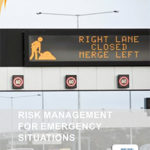
The World Road Association – PIARC recently published a Report titled: “Risk Management for Emergency Situations“. In this Report, an effort was made to analyze world practices in emergency situation management and present integrated frameworks for risk and business continuity planning. This has produced recommendations for best practice in managing risk and emergency situations both generally and across the road network in particular. ![]()
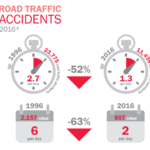
The Hellenic Statistical Authority (ELSTAT) recently announced the results of the Road traffic accidents survey for the 2016. This infographic visualises data regarding accidents, persons killed and persons injured in 2016 in Greece. In Attica, approximately 6.000 accidents took place, 7.000 persons persons (seriously or slightly) injured, and 201 persons killed. ![]()
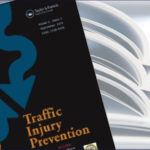
A paper titled ‘Investigation of powered 2-wheeler (PTW) accident involvement in urban arterials by considering real-time traffic and weather data‘ co-authored by Athanasios Theofilatos and George Yannis is now published in Traffic Injury Prevention Journal. This study exploited real-time traffic and weather data from two major urban arterials in the city of Athens, Greece. Because of the high number of candidate variables, a random forest model was applied to reveal the most important variables. Then, the potentially significant variables were used as input to a Bayesian logistic regression model in order to reveal the magnitude of their effect on PTW accident involvement. The results of the analysis suggest that PTWs are more likely to be involved in multi-vehicle accidents than in single-vehicle accidents. It was also indicated that increased traffic flow and variations in speed have a significant influence on PTW accident involvement. ![]()

The first SSATP Annual Meeting under the Third Development Plan (DP3) took place with great success in Marrakech, Morocco during the week of February 20-24, 2017. Within this Annual Meeting a Workshop regarding road safety data was co-organised by the Africa Transport Policy Program (SSATP) of the World Bank and the International Road Traffic Accident Database organisation (IRTAD) of the ITF/OECD, in which several road safety experts and stakeholders from Africa and worldwide contributed in vivid discussion for the improvement of road safety data in Africa. ![]()
NTUA presentations concerned:
![]() Quelles données de sécurité routière pour quels usages? Les acteurs
Quelles données de sécurité routière pour quels usages? Les acteurs
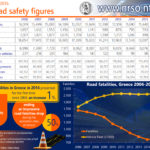
Road fatalities in Greece in 2016 presented an increase (1%) for the first time since 2004, ending an impressive road fatalities drop during the economic crisis of almost 50%, as highlighted at the comprehensive statistics table based on recently published ELSTAT data.
During the last five years, road fatalities in Greece have decreased by 29% (since 2011), however injury road accidents decreased only by 17%. The rate fatalities per number of vehicles has decreased by 30% since 2011. ![]()

Basic characteristics of road fatalities in Greece for the period 1991-2015 are summarised in a comprehensive Table prepared by the NTUA Road Safety Observatory (data source: ELSTAT). Since 2005, there are approximately 1.000 less road fatalities per year in Greece. According to these time series data a spectacular decrease in road fatalities for young people (68%) and children (86%) is observed during the last decade, as well in fatalities outside urban areas, especially when raining and in accidents with heavy goods vehicles. On the contrary, fatalities decrease during the last decade is quite limited for motorcyclists and cyclists, older drivers, men drivers, single vehicle accidents, as well as in junctions outside built-up areas. ![]()
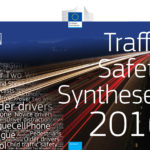
European Commission recently launched Traffic Safety Synthesis 2016, prepared by European Road Safety Observatory (ERSO), with the active contribution of NTUA. The European Road Safety Observatory (ERSO) gathers harmonised specialist information on road safety practices and policy in European countries. Evidenced-based approaches lie at the heart of the most successful road safety polices – backed up by accident and other road safety data. ERSO collects a range of information types including a series of data protocols and collection methodologies, national and in-depth accident data, exposure data and safety performance indicators. ERSO was developed by the SafetyNet project and was later updated and expanded by the DaCoTA project. Current updates are managed by the EU’s Directorate-General for Mobility and Transport. ![]()
The Traffic Safety Synthesis 2016 includes 22 key traffic safety topics:
 Advanced driver assistance systems
Advanced driver assistance systems Alcohol
Alcohol Cell phone use while driving
Cell phone use while driving Children
Children Cost Benefit Analysis
Cost Benefit Analysis Driver Distraction
Driver Distraction Fatigue
Fatigue Integration of Road Safety in Other Policy Areas: Synergies and Conflicts
Integration of Road Safety in Other Policy Areas: Synergies and Conflicts Novice Drivers
Novice Drivers Older Drivers
Older Drivers Pedestrians and Cyclists
Pedestrians and Cyclists Post-impact care
Post-impact care Power two wheelers
Power two wheelers Quantitative Road Safety Targets
Quantitative Road Safety Targets Roads
Roads Road Safety Management
Road Safety Management Safety Ratings
Safety Ratings Serious Injuries
Serious Injuries Speed and Speed Management
Speed and Speed Management Speed Enforcement
Speed Enforcement Vehicle Safety
Vehicle Safety Work-related
Work-related
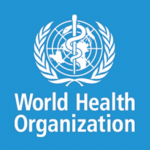
The World Health Organisation (WHO) released a discussion paper concerning “Developing voluntary global performance targets for road safety risk factors and service delivery mechanisms“. This paper puts forward a set of voluntary global performance targets for the prevention of road traffic injuries, as well as the indicators that will be used to assess their achievement for Member States consideration and assist global road safety policy efforts.
Selected targets should be based on sound scientific evidence, have related indicators that are measurable, and politically supported. This paper proposes a selection of global targets based on these considerations, and specifies a limited set of indicators that may be used by participating countries to monitor progress towards the achievement of these targets. ![]()
![]()
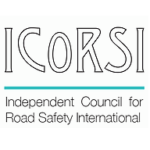
The Independent Council for Road Safety International (ICoRSI) is a recently launched new not-for profit organization, which provides independent authoritative advice on global road safety policies by road safety scientists that have no financial conflicts of interest. ICoRSI aims to provide rapid, independent and evidence-based information on road safety policy and practice to policy makers and the public, strengthen the capacity of safety professionals and policy makers to understand existing evidence and undertake new research and facilitate in capacity building for safety professionals and policy makers in the field of transportation safety. ![]()
ICoRSI has recently launched comments on WHO’s draft global targets for road safety risk factors. ![]()
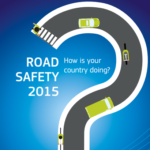
The European Commission has published a leaflet demonstrating the road safety situation at the end of 2015 and the progress made since 2010 in the EU countries. The target of the EU was to halve the number of road fatalities on European roads by 2020. The purpose of this leaflet is to allow Member States and European citizens to compare their situation and to encourage them to continue their efforts regarding road safety. ![]()
It is the first time that comparative figures on serious injuries and hospitalised casualties are published in Europe, exploiting the new harmonised definition based on MAIS3+.

TRAVisions concerns two competitions for transport research awards to be announced in a prestigious award ceremony at the Transport Research Arena Conference on 16-19th April 2018 in Vienna: ![]()
![]()
![]()
- TRAVisions 2018 Young Researcher Competition, an academic student competition with the goal of stimulating the interest among young researchers and students in the field of sustainable surface transport

- TRAVisions 2018 Senior Researcher Competition , a competition for senior researchers in the field of innovative surface transport concepts based on results only from EU-funded projects
 .
.
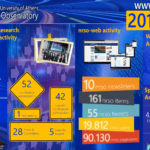
The infographic of the 2016 NTUA Road Safety Observatory (www.nrso.ntua.gr) highlights one more very intensive year, striving with highly scientific expertise to improve road safety in Greece, in Europe and worldwide.
The nrso people with excellent dedication, efficiency and expertise were active in 13 innovative research projects, succeeded to publish more than 55 scientific papers (21 in peer reviewed journals), achieved more than 38.500 visits of the nrso website, handled more than 75.000 emails and run more than 4.500 km! ![]()

The 10th Panhellenic Conference on Alzheimer’s Disease and Related Disorders and the 2nd Mediterranean Conference on Neurodegenerative Diseases, took place with great success in Thessaloniki, on 2-5 February 2017. The Panhellenic Institute of Neurodegenerative Diseases, in cooperation with the Greek Association of Alzheimer’s Disease and Related Disorders organized this, well-established, meeting of top scientists from Greece and around the world, at the fertile ground of a Conference, which for sixteen years informs and educates health professionals and caregivers. ![]()
A special session dedicated to “driving behavior in patients with mild cognitive impairment and Alzheimer’s disease” included the NTUA presentation:
![]() Drivers with AD and MCI: The predictive value of neurological and neuropsychological measures
Drivers with AD and MCI: The predictive value of neurological and neuropsychological measures
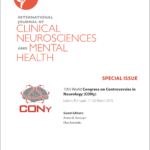
A paper titled “Does the diagnosis of Alzheimer’s Disease implies immediate revocation of a driving license?” authored by Sokratis G. Papageorgiou, Ion N. Beratis, Dionysia Kontaxopoulou, Stella Fragkiadaki, Dimosthenis Pavlou, and George Yannis is now published in International Journal of Clinical Neurosciences and Mental Health. Based on previous findings, patients with Alzheimer’s Disease (AD) commonly present increased driving difficulties at a level that clearly supports the discontinuation of driving. Nonetheless, some patients with AD, retain adequate driving skills that are similar to those of cognitively intact individuals of similar age, whereas drivers with MCI present an accentuated risk to develop driving difficulties, but their performance is not consistently worse than that of healthy control drivers. Under this perspective this research suggests the need for implementing a personalized approach when taking decisions about the driving competence of drivers with AD and MCI that is based on the effective synthesis of multimodal driving-related indexes by the specialities of neurology, neuro-psychology and traffic engineering. ![]()

The European Transport Safety Council (ETSC) released a Report concerning Targeted safety measures needed to prevent road deaths among young drivers, authored by Laurence Atchison. Zero tolerance on drink driving, additional hazard perception training and graduated driver licensing schemes should become the norm in order to help tackle the disproportionate risks faced by young drivers and motorcycle riders in Europe, according to this new ETSC Report.
Commenting on the report, Antonio Avenoso, Executive Director of the European Transport Safety Council said: “With thousands of young people’s lives still being tragically cut short every year in Europe, we need policymakers to commit urgently to introducing smart, cost-effective and proven measures that can bring these numbers down. ![]()
![]()
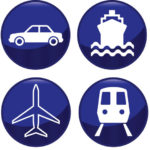
The International Transport Forum (ITF) launched recently a Draft Discussion Paper titled “Overcoming Obstacles to Implementing Safety Management Systems”, prepared for the Roundtable on Safety Management Systems (March 23-24, 2017, Paris), authored by Jouni Lappalainen. The purpose of this paper is to examine the obstacles to implementing safety management systems and to discuss solutions for overcoming those obstacles in the four modes of transport: aviation, maritime, rail and road. These four transport modes can be considered to represent safety critical industries. ![]()
![]()
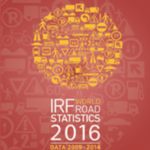
Since 52 years, the International Road Federation (IRF) World Road Statistics (WRS) continue to be the major comprehensive, universal source of statistical data on road networks, traffic and inland transport. Over the past years, the WRS have proved to be an invaluable and internationally accepted reference tool for governments, NGOs, investments banks, research institutes and anyone analyzing and reporting trends in key subject areas like traffic volumes and vehicle usage, road expenditure, road safety, energy consumption and emissions. ![]()
This year, the WRS 2016 (data 2009-2014) features more than 200 countries, with data on over 45 road related topics, presented in nine substantive sections, with the active contribution of NTUA for the Greek data. This is a tremendous achievement that complements the work accomplished last years with the 2015, 2014 and 50th Anniversary Editions. ![]()
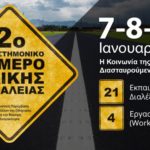
The Hellenic Association of Driving Instructors with the support of the Hellenic Institute of Transportation Engineers, the Hellenic Society of Automotive Engineers, organised the 2nd Interdisciplinary Conference “Society of Traffic and Road Safety: Crossing Glances”, which took place with great success in Athens on 7-9 January 2017. This Interdisciplinary Road Safety Conference brought together all road safety experts, stakeholders and Authorities in Greece in order to discuss current road accident problems and solutions in Greece with emphasis on road safety training and education. ![]()
NTUA presentations concerned:
![]() Autonomous vehicles safety challenges
Autonomous vehicles safety challenges
![]() The role of driving instructors on mixed traffic of autonomous and not-autonomous vehicles
The role of driving instructors on mixed traffic of autonomous and not-autonomous vehicles

The Hellenic Ministry of Infrastructure, Transport and Networks, realizing the objectives of the policy agenda and the commitments under the National Action Plan (ITS Action Plan 2012), launched for the first time, a particularly important action which is expected to mark a new era for Intelligent Transport Systems (ITS) in Greece: the National Architecture for Intelligent Transport Systems.
The action was carried out by teams of experts coordinated by the Department of Planning and Development of Transport of the Ministry and is based on internationally accepted concepts. The action is based on the involvement of all stakeholders through wide and open consultation process. ![]()
![]()
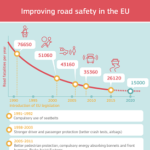
The European Commission recently set out a range of advanced safety measures that could be fitted to vehicles in the future and have the potential to save lives on the roads. These measures will be examined in detail to decide exactly how the vehicles of tomorrow will be made safer. The report presents workable and cost-effective car safety measures. The main objectives are to decrease the number of road victims and to help prevent accidents. As vulnerable road users, special attention was given to children and the elderly. ![]()
![]()














































































































































































